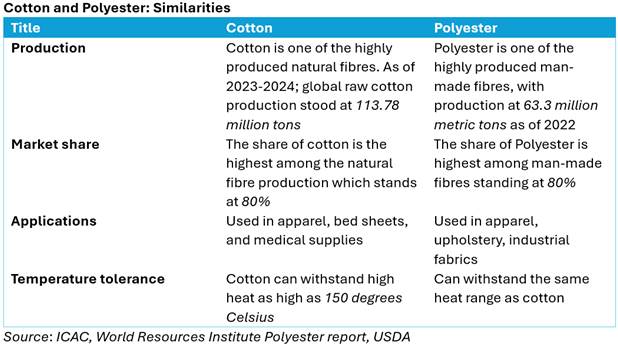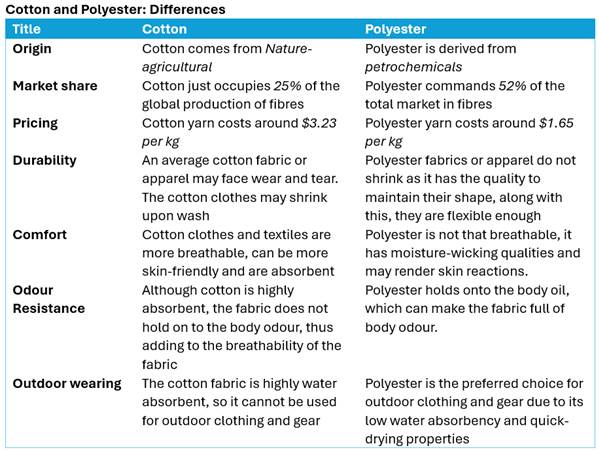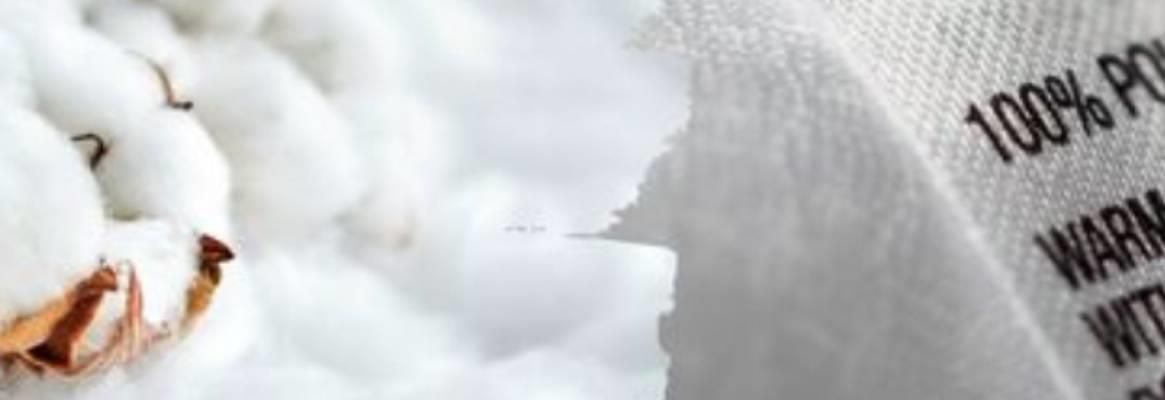Cotton and polyester are two of the most dominant fibres in the textile world. Cotton is a natural fibre coming from the seedpod of the cotton plant and has been in existence for thousands of years. Polyester, having been created in the 1940s is a synthetic fibre made from a chemical reaction involving petroleum, air, and water. Some say the best of both worlds is a blend of 50 per cent cotton and 50 per cent polyester as one can have the softness of cotton with the increased durability of polyester.
Cotton vs Polyester: Introduction
Cotton fibres, harvested from annually grown plants, are composed entirely of cellulose. Known for its comfort and breathability, cotton’s absorbency is a result of its processing.
Polyester, a synthetic fabric typically derived from petroleum, is the most widely used synthetic textile globally. It serves numerous consumer and industrial applications. Chemically, polyester is a polymer mainly consisting of ester compounds. Both synthetic and some plant-based polyester fibres are produced from ethylene, a petroleum component also obtainable from other sources. However, polyester production and use significantly contribute to environmental pollution worldwide.
However, there are also similarities between the two rivals of the textile world. Although highly distinctive right from the origin of the products, the two can be quite similar in terms of the macros in the market, and the applications for the products. The following are some of the similarities between cotton and Polyester.

Cotton fabric is one of the most widely used fabrics in the world. It is used in everything from bedding to socks to coffee filters. Also, cotton fibres can be woven together to create completely new fabrics such as velvet, corduroy, flannel, jersey, and denim. Cotton, however, does not work as well in outdoor gear due to its high absorbency and lack of water resistance. For this reason, polyester trumps cotton for outdoor clothing and gear.
Polyester as the number one man-made fabric in the world also has a wide variety of applications – from jackets to scarves to backpacks. It is a great outdoor fabric – polyester jackets, hoodies, and sleeping bags keep people warm on a cold hike. And its water resistance will keep them dry. It performs very well in different weather conditions and is long-lasting and durable. Polyester insulation and fleece are a popular use for polyester also.
The Economics of the Supply Chains
The textile industry overall has immense importance and so do cotton and polyester. Having a significant market size, there are more than 40 industries globally involved in the production of man-made fibre, fabrics and yarn, which also provides significant employment to a lot of people.
Likewise, cotton also has a lot of benefits. Cotton value chains are of immense importance to developing countries, not only from the perspective of wearing the cloth and the features, but cotton also has a lot to offer from an economic perspective. Natural fibres like cotton have their own value chain, which provide livelihoods to many. In India alone, the value chain employs 6 million farmers and more than 40-50 million in the other processing industry, according to the International Labour Organisation. Thus, cotton has immense importance when looked at from an economic perspective.
However, even though there are a lot of economic benefits, there are significant differences in terms of market share, price and quality. Also, sustainability is one of the most important factors.

Environmental Impact
If one looks at cotton and polyester value chains, their method of production, and the impact they have on the environment, circular methods of production have to be taken into consideration. The table below shows the impact of polyester and cotton on the environment:

With cotton production estimated to reach around 29 million tons globally by 2029, one has to look at the environmental impact of the ‘White gold’. The water consumption of cotton fabric is immense as compared to polyester fabric which points out the water-intensive nature of the natural fabric. In addition, although cotton is one of the naturally available textile raw materials, conventional cotton farming uses the most pesticides of any crop in the world. The cotton plantation alone consumes around 16 per cent of insecticides and 7 per cent of herbicides used worldwide. And every time it rains, or the plant decomposes, these chemicals leak into the groundwater and surrounding waterways.
Moreover, cotton takes a lot of land and water to grow and needs to be harvested using motorised farming equipment. It is estimated that 77.91 million acres globally is under cotton cultivation, along with 1,931 litres of irrigation water to produce 1 kg lint. So all-in-all cotton demands significant land and water resources.
On the other hand, the polyester fibre requires around 100 litres of water, and another 60 litres of water for the fabric production. Along with this, water pollution is also immense. More than 50 per cent of the chemicals used are dumped in the water stream untreated.
Overall, polyester harms the environment at every stage of its production, and it inevitably accumulates in the world’s ecosystems and oceans with no viable methods for removing it. The advent of plant-based polyester fibre would seem to be a step toward reversing this unfortunate situation, and the introduction of PET offers a way to deal with waste polyester and plastic bottles. As of today, it remains unclear whether these alternatives to petroleum-based polyester will gain enough traction within the textile market to make an impact on the polluting effects of polyester.
Cotton vs Polyester: Conclusion
Both cotton and polyester have distinct properties and are often blended to leverage their respective advantages. Cotton, being natural and biodegradable, has an environmental edge. However, both fibres are incredibly versatile and find diversified applications.
For comfortable, breathable T-shirts or crisp, fresh bed sheets, 100 per cent cotton is the preferred choice. On the other hand, if you need protection from the elements during a camping expedition, polyester garments, especially those made from sustainable PET or plant-based sources, are ideal.
From a sustainability perspective, organic cotton and recycled polyester are the best options. When comparing these, polyester tends to be cheaper than cotton. However, it will take time for the sustainability trend to become more mainstream.









Comments